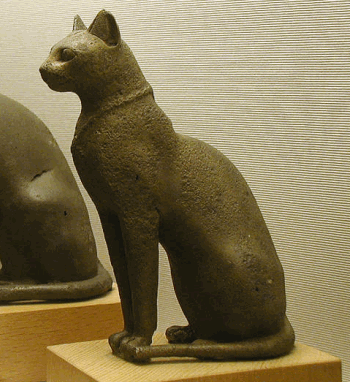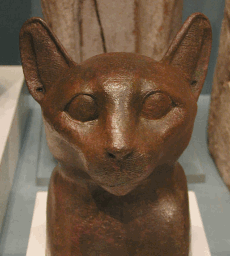Basted

A bronze statue of the goddess Bastet, from the Late Period, on display at the Ashmolean Museum at Oxford.
Bastet (sometimes also spelled Bast, Baast, Ubasti and Baset) was the goddess of music, joy and motherhood whose religious center was in the city of Bubastis in Egypt.
Bastet was a feline goddess, initially depicted as a lioness but over time identified with the domesticated cat, which was sacred to her. Bastet was depicted as either a woman with feline features, or as a cat outright.
Cats held an extremely high position within Egyptian society. It was in Egypt that cats were first domesticated, and at first they were used solely to combat the rats that attacked the granaries. But in time cats came to be regarded as sacred animals and every house and temple had at least one cat, which held a high social status.
Cats were well looked after and were often allowed to eat from their master's plate. When a cat died, he was usually buried with honor and ceremony. Most were embalmed, just like humans, indicating perhaps a belief that cats, too, would enjoy an afterlife. Several ancient Egyptian cat cemeteries have been uncovered, containing hundreds of thousands of embalmed cats. Egyptians would shave their eyebrows when their household cat died, as a sign of mourning.
There were priests and temples devoted to the worship of Bastet, and by extension to the domesticated cat, which was the incarnation of Baat. Cats were held so sacred that it was forbidden to mistreat them or to export them from Egypt, under penalty of death, but the Phoenician traders managed to smuggle the animals to other countries, so that the cat traveled the trade routes to all parts of the world, and thus shared in the rise of human civilization.

Bronze mask from the mummy of a cat.
The annual celebration at the city of Bubastis, in honor of the goddess Bastet, was a highly anticipated event in Egypt. Herodotus gives a vivid description of this cat festival, which he claimed was attended annually by 700,000 people not including their children. For a long time Herodotus's account was believed to be fictional and an invention of the historian, but modern archaeologists have discovered evidence confirming the existence of this holiday and its importance. The festival of Bastet was one of the most popular in the Egyptian calendar. Thousands of people would flock to the holy city devoted to the worship of the cat.
During the festival the embalmed bodies of dead cats were presented to the goddess Bastet and buried by the thousands in underground galleries beneath the city, so that they could carry messages from their master to the realm of the gods.
pyramids Egypt Mummies Search Engines Link Report
Egyptian Cities | Egyptian Education | Ancient Egypt | egyptian clothing | Egyptian Houses | The Egyptians | Egyptian Family Life | Egypt and its Neighbours | Government in Ancient Egypt | Egyptian History | Military | Organization of Ancient Egypt | Recreation | Egyptian Religion | Pyramids | About | Privacy Policy | Site News | Site Map
EgyptPast.com - Facts and Information About the History of Ancient Egypt
-